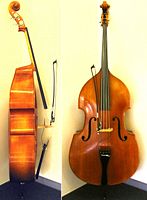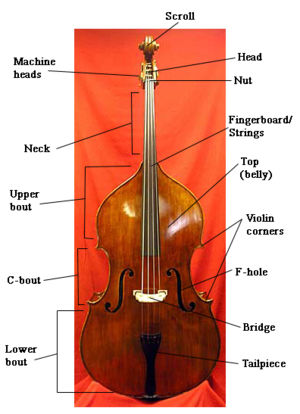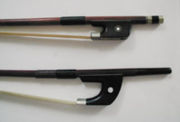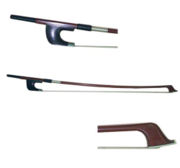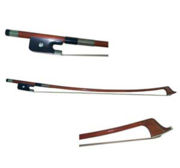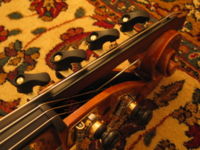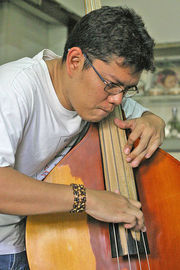Double bass
2008/9 Schools Wikipedia Selection. Related subjects: Musical Instruments
|
The double bass (also known as the contrabass, string bass, upright bass, bull fiddle, bass fiddle, bass violin, or simply bass) is the largest and lowest pitched bowed string instrument used in the modern symphony orchestra. It is the a standard member of the string section of the symphony orchestra and smaller string ensembles in Western classical music. In addition, it is used in other genres such as jazz, 1950s-style blues and rock and roll, rockabilly/ psychobilly, bluegrass, and tango.
Double basses are constructed from several types of wood, including maple for the back, spruce for the top, and ebony for the fingerboard. It is uncertain whether the instrument is a descendant of the viola da gamba family or from the violin family; while the double bass has features which are similar to those found on violin family instruments, it also has features which may be derived from the viol family.
Like many other string instruments, the double bass is played either with a bow (arco) or by plucking the strings ( pizzicato). In orchestral repertoire and tango music, both bowing and plucking styles are used. In jazz music, the bass is mostly plucked, except for some solos which are performed with the bow. In most other genres, such as blues and rockabilly, the bass is plucked.
History
The double bass is generally regarded as the only modern descendant of the viola da gamba family of instruments, a family which originated in Europe in the 15th century, and as such it has been described as a "bass viol." Before the 20th century many double basses had only three strings, in contrast to the five to six strings typical of instruments in the viola da gamba family or the four strings of instruments in the violin family. Some existing instruments, such as those by Gasparo da Salò, were converted from sixteenth-century six-string contrabass violoni.
The double bass's proportions are dissimilar to those of the violin and cello; for example, it is deeper (the distance from top to back is proportionally much greater than the violin). In addition, while the violin has bulging shoulders, most double basses have shoulders carved with a more acute slope, like members of the viola da gamba family. Many very old double basses have had their shoulders cut or sloped to aid playing with modern techniques. Before these modifications, the design of their shoulders was closer to instruments of the violin family.
The double bass is the only modern bowed string instrument that is usually tuned in fourths (like viols), rather than fifths (see Tuning, below). The issue of the instrument's exact lineage is still a matter of some debate, and the supposition that the double bass is a direct descendant of the viola da gamba family is an issue that has not been entirely resolved.
In his A New History of the Double Bass, Paul Brun asserts, with many references, that the double bass has origins as the true bass of the violin family. He states that, while the exterior of the double bass may resemble the viola da gamba, the internal construction of the double bass is nearly identical to that of other instruments in the violin family, and is very different from the internal structure of viols.
Terminology
A person who plays this instrument is called a bassist, double bassist, double bass player, contrabassist, contrabass player, or simply bass player. The instrument's standard English name, double bass is derived from the tuning of one octave lower than the cello. It is not related to physical size. The name may derive from its alleged viol family heritage, in that it is tuned lower than the standard bass viola da gamba. The name also refers to the fact that the sounding pitch of the double bass is an octave below the bass clef.
Other terms for the instrument among classical performers are contrabass (which comes from the instrument's Italian name, contrabbasso), string bass, or simply bass. Jazz musicians often call it the upright bass to distinguish it from the electric bass guitar. Especially when used in folk and bluegrass music, the instrument can also be referred to as an upright bass, standup bass, bass fiddle, or bass violin (or more rarely as doghouse bass or bull fiddle). Other colourful nicknames are found in other languages; in Hungarian, for instance, the double bass is sometimes called nagy bőgő, which roughly translates as "big crier", referring to its large voice.
Design
The design of the double bass, in contrast to the instruments in the violin family, has never been fully standardized. In general there are two major approaches to the design outline shape of the double bass, these being the violin form, and the viol da gamba form. A third less common design called the busetto shape (and very rarely the guitar or pear shape) can also be found. The back of the instrument can vary from being a round, carved back similar to that of the violin, or a flat and angled back similar to the viol family.
The double bass features many parts that are similar to members of the violin family including a bridge, f-holes, a tailpiece, a scroll and a sound post. Unlike the rest of the violin family, the double bass still reflects influence and can be considered partly derived from the viol family of instruments, in particular the violone, the bass member of the viol family.
The double bass also differs from members of the violin family in that the shoulders are (sometimes) sloped, the back is often angled (both to allow easier access to the instrument, particularly in the upper range), and machine tuners are always fitted. Lack of standardization in design means that one double bass can sound and look very different from another. To see some of the variations and construction approaches discussed above visit the websites quoted below.
Construction
The double bass is closest in construction to violins, but has some notable similarities to the violone (literally "large viol"), the largest and lowest member of the viola da gamba family. Unlike the violone, however, the fingerboard of the double bass is unfretted, and the double bass has fewer strings (the violone, like most viols, generally had six strings, although some specimens had five or four).
An important distinction between the double bass and other members of the violin family is the construction of the pegbox. While the violin, viola, and cello all use friction pegs for gross tuning adjustments, the double bass has machine heads. This development makes fine tuners unnecessary. At the base of the double bass is a metal spike called the endpin, which rests on the floor. This endpin is generally more robust than that of a cello, because of the greater mass of the instrument.
The soundpost and bass bar are components of the internal construction. The materials most often used are maple (back, neck, ribs), spruce (top), and ebony (fingerboard, tailpiece). The exception to this are less-expensive basses which have laminated ( plywood) tops, backs, and ribs. These basses are resistant to changes in heat and humidity, which can cause cracks in spruce tops. Composite material basses, which are used in music schools, are very resistant to humidity and heat, as well to the physical abuse they are apt to encounter in such an environment.
All parts are glued together except the soundpost, bridge and tailpiece, which are held in place by string tension. The tuning machines are attached to the sides of the pegbox with wood screws. The key on the tuning machine turns a worm, driving a worm gear that winds the string.
Strings
Prior to the late 1900s, double bass strings were usually made of gut, but since that time, steel strings have largely replaced gut strings, because steel strings hold their pitch better and yield more volume when played with the bow. Gut strings are also more vulnerable to changes of humidity and temperature, and they break much more easily than steel strings. Gut strings are nowadays mostly used by bassists who perform in baroque ensembles, rockabilly bands, traditional blues bands, and bluegrass bands. Gut strings, because they produce a "thumpy," darker tone when they are played pizzicato, better approximate the sound heard on 1940s and 1950s recordings. Rockabilly and bluegrass bassists also prefer gut because it is much easier to perform the "slapping" upright bass style (in which the strings are percussively slapped and clicked against the fingerboard) with gut strings than with steel strings. (For more information on slapping, see the sections below on Modern playing styles, Double bass in bluegrass music, Double bass in jazz, and Double bass in popular music).
The change from gut to steel has also affected the instrument's playing technique over the last hundred years, because playing with steel strings allows the strings to be set up closer to the fingerboard, and, additionally, steel strings can be played in higher positions on the lower strings and still produce clear tone. The classic 19th century Franz Simandl method does not utilize the low E string in higher positions because with older gut strings set up high over the fingerboard, the tone was not clear in these higher positions. However, with modern steel strings, bassists can play with clear tone in higher positions on the low E and A strings, particularly when modern lighter-gauge, lower-tension steel strings (e.g., Corelli/Savarez strings) are used.
Bows
The double bass bow comes in two distinct forms. The "French" or "overhand" bow is similar in shape and implementation to the bow used on the other members of the orchestral string instrument family, while the "German" or "Butler" bow is typically broader and shorter, and is held in a very natural hand shake position.
These two bows provide for different ways of moving the arm and distributing force on the strings. The French bow, because of the angle the hand holds the bow, is touted to be more maneuverable. The German bow is claimed to allow the player to apply more arm weight on the strings. The differences between the two, however, are minute for a proficient player trained in using his/her respective bow. Both bows are used by modern players, and the choice between the two is a matter of personal preference.
German bow
The German bow (sometimes called Dragonetti bow) is the older of the two designs. The bowing style was handed down from when the bows of all stringed instruments had to be held in that fashion (middle two fingers between the stick and the hair) to maintain tension of the hair before screw threads were used. Proponents of the use of German bow claim that the German bow is easier to use for such bow strokes as staccato, spiccato, and detaché.
The German bow has a taller frog, and is held with the palm angled upwards, as used for the upright members of the viol family. When held in correct manner, the thumb rests on the side of the stick. The index finger balances the bow at the point where the frog meets the stick. The index finger is also used to apply an upward torque to the frog when tilting the bow. The little finger supports the frog from underneath, while the ring finger and middle finger are used to apply the force to move the bow across the strings.
French bow
The French bow was not widely popular until its adoption by 19th-century virtuoso Giovanni Bottesini. This style is more similar to the traditional bows of the smaller string family instruments. It is held as if the hand is resting comfortably by the side of the performer with the palm facing toward the bass. The thumb rests on the shaft of the bow, next to the frog while the other fingers drape on the other side of the bow. Various styles dictate the curve of the fingers and thumb, as do the style of piece- a more pronounced curve and lighter hold on the bow is used for virtuosic or more delicate pieces, while a flatter curve and sturdier grip on the bow provides more power for rich orchestral passages.
Bow construction and materials
Pernambuco is regarded by many players as the best stick material, but due to its scarcity and expense, other materials are used in less expensive bows nowadays. Less expensive student bows may be constructed of solid fibreglass, or of less valuable varieties of brazilwood.
Snakewood and carbon fibre are also used in bows of a variety of different qualities. The frog of the double bass bow is usually made out of ebony, although Snakewood and buffalo horn are used by some luthiers. The wire wrapping is gold or silver in quality bows, and the hair is usually horsehair. Some of the lowest-quality student bows feature synthetic fibreglass "hair". Double bass bows vary in length, but average around 24" (60 cm).
The double bass bow is strung with either white or black horsehair, or a combination of the two (known as "salt and pepper"), as opposed to the customary white horsehair used on the bows of other string instruments. The slightly rougher black hair is believed by some to "grab" the heavier strings better; similarly, some bassists and luthiers believe that it is easier to produce a smoother sound with the white variety. Red hair is also used by some bassists.
Rosin
String players apply rosin to the hair of their bows so that the hair will "grip" the string and make it vibrate. Double bass rosin is generally softer and stickier than violin rosin to allow the hair to grab the thicker strings better, but players use a wide variety of rosins that vary from quite hard (like violin rosin) to quite soft, depending on the weather, the humidity, and the preference of the player. The amount used generally depends on the type of music being performed as well as the personal preferences of the player. Bassists may apply more rosin in works for large orchestra (e.g., Brahms symphonies) than for delicate chamber works. Some brands of rosin, such as Pop's double bass rosin, are softer and more prone to melting in hot weather. Other brands, such as Carlsson or Nyman Hartz double bass rosin, are harder and less prone to melting.
Pitch
The lowest note of a double bass is an E1 (on standard four-string basses) at approximately 41 Hz or a B0 (when five strings are used) at approximately 31 Hz. This is slightly above the lowest sound the average human ear can perceive, at 20 Hz. The highest notes are almost down at the bridge. Five string instruments either use the additional string tuned to a low B below the E string, or to a C above the G string.
In many double bass concertos harmonic tones are used. The use of natural harmonics (a technique often used by Giovanni Bottesini) and sometimes even "false" harmonics, where the thumb stops the note and the octave or other harmonic is activated by lightly touching the string at the relative node point, extend the double bass' range considerably.
The double bass parts from most orchestral music rarely exceed three octaves. However, a virtuoso solo player could cover five or six octaves in solo bass repertoire, using natural and artificial harmonics.
Since the range of the double bass lies largely below the standard bass clef, it is notated an octave higher (hence sounding an octave lower than written). This transposition applies even when reading the tenor and treble clef, which are used to avoid excessive ledger lines when notating the instrument's upper range.
Tuning
The double bass is generally tuned in fourths, in contrast to the other members of the orchestral string family, which are tuned in fifths. This avoids too long a finger stretch (known as an "extension"). Modern double basses are usually tuned (low to high) E-A-D-G. The lowest string is tuned to E (the same pitch as the lowest E on a modern piano, approximately 41 cycles per second), nearly three octaves below middle C); and the highest string is tuned to G, an octave and a fourth below middle C (approximately 98 cycles per second).
A variety of tunings and numbers of strings were used on a variety of confusingly-named instruments through the sixteenth to the early twentieth centuries, by which time the four-stringed tuning mentioned above became almost universal.
Much of the classical repertoire has notes that fall below the range of a standard double bass. Notes below low E appear regularly in double bass parts in the Baroque and Classical eras, when the double bass was typically doubling the cello part an octave below. In the Romantic era and the 20th-century, composers such as Mahler, Beethoven, and Prokofiev also requested notes below the low E.
There are two common methods for making these notes available to the player. Major European orchestras generally use basses with a fifth string, tuned to B three octaves and a semitone below middle C.
In the United States, Canada and United Kingdom, most professional orchestral players use four-string double basses with an "C extension" which extends the lowest string down as far as low C, an octave below the lowest note on the cello (more rarely, this string may be tuned to a low B). The extension is an extra section of fingerboard mounted up over the head of the bass, which requires the player to reach back over the pegs to play, or to use a mechanical lever system.
A small number of bass players tune their strings in fifths, like a cello but an octave lower (C-G-D-A low to high). This tuning was used by the jazz player Red Mitchell and is increasingly used by classical players, notably the Canadian bassist Joel Quarrington. Tuning in fifths can also make the instrument louder, because the strings have more common overtones, causing the strings to vibrate sympathetically.
In classical solo playing the double bass is usually tuned a whole tone higher (F♯-B-E-A). This higher tuning is called "solo tuning," whereas the regular tuning is known as "orchestral tuning." String tension differs so much between solo and orchestral tuning that a different set of strings is often employed that has a lighter gauge. Strings are always labelled for either solo or orchestral tuning, and published solo music is arranged for either solo or orchestral tuning. Some popular solos and concerti, such as the Koussevitsky Concerto are available in both solo and orchestral tuning arrangements.
A variant and much less-commonly used form of solo tuning used in some Eastern European countries is (A-D-G-C), which uses three of the strings from orchestral tuning (A-D-G) and then adds a high "C" string. Some bassists with five string basses use a high "C" string as the fifth string, instead of a low "B" string. Adding the high "C" string facilitates the performance of solo repertoire with a high tessitura (range).
Playing and performance problems
Double bassists have the option to either stand or sit while playing the instrument. When standing, the double bass' height is set (by adjusting the endpin) so that the player may easily place the right hand close to the bridge, either with the bow (arco) or plucking (pizzicato). While personal opinions vary, often the endpin is set by aligning the first finger in either first or half position with the player's eye level. While sitting, a stool (which is measured by the player's seam length) is used. Traditionally, standing has been preferred by soloists although many now choose to play sitting down.
When playing in the upper register of the instrument (above the G below middle C), the player shifts his hand out from behind the neck and flattens it out, using the side of his thumb as a finger. This technique is called thumb position and is also a technique used on the cello. While playing in thumb position, the use of the fourth finger is replaced by the third finger, as the fourth finger becomes too short to produce a reliable tone.
Despite the size of the instrument, it does not project a loud volume, because its range is so low. When the bass is being used as an ensemble instrument in orchestra, usually between four and eight bassists will play the part in unison. In jazz and blues settings, the bass is normally amplified with a bass amplifier and loudspeakers. When writing solo passages for the bass, composers typically ensure that the orchestration is light, so it will not cover the bass.
Performing on the bass can be physically taxing because the strings of the bass are larger and thicker than those of a smaller stringed instrument. As well, since the bass is much larger than other stringed instruments, the space between notes on the fingerboard is larger. As a result, bass parts have relatively fewer fast passages, double stops, or large jumps in range. The increased use of playing techniques such as thumb position and modifications to the bass such as the use of lighter-gauge strings have reduced this problem to some degree.
As with all unfretted string instruments, performers must learn to place their fingers precisely to obtain the correct pitch. Because the bass is larger than other string instruments, the positions for the fingers are much further apart. As a result, more shifting of position is required, which increases the likelihood of intonation errors. As well, for bassists with smaller hands, the large spaces between pitches on the bass fingerboard may present a challenge, especially in the lower range, where the spaces between notes are largest.
Until the 1990s, child-sized double basses were not widely available, and the large size of the bass meant that children were not able to start the bass until their hand size and height would allow them to play a 3/4-size instrument (the most commonly-available size). In the 1990s and 2000s, smaller half, quarter, eighth and even sixteenth-sized instruments became more widely available, which meant that children could start at a younger age.
The double bass's large size, combined with the fragility of the wooden top and sides and the wood make safely transporting the instrument difficult. Since hard cases are both expensive and heavy, many bassists use soft cases. Some players use wheeled carts or endpin-attached wheels to transport the instrument.
Classical repertoire
Solo works for double bass
1700s
The double bass as a solo instrument enjoyed a period of popularity during the 18th century and many of the most popular composers from that era wrote pieces for the double bass. The double bass, then often referred to as the Violone used different tunings from region to region. The "Viennese tuning" (A-D-F♯-A) was popular, and in some cases a fifth string or even sixth string was added. The popularity of the instrument is documented in Leopold Mozart's second edition of his Violinschulë, where he writes "One can bring forth difficult passages easier with the five-string violone, and I heard unusually beautiful performances of concertos, trios, solos, etc."
The earliest known concerto to exist for the double bass was written by Joseph Haydn ca.1763, which is now lost. The earliest concertos that exist today are by Karl Ditters von Dittersdorf, who composed two concertos for the double bass and a Sinfonia Concertante for viola and double bass. Other composers that have written concertos from this period include Johann Baptist Vanhal, Franz Anton Hoffmeister (3 concertos), Leopold Kozeluch, Anton Zimmermann, Antonio Capuzzi, Wenzel Pichl (2 concertos), and Johannes Matthias Sperger (18 concertos).
While many of these names were leading figures to the music public of their time, they are generally unknown by contemporary audiences. Wolfgang Amadeus Mozart's concert aria, "Per Questa Bella Mano", K.612 for bass, double bass obbligato, and orchestra contains impressive writing for solo double bass of that period. It remains popular among both singers and double bassists today.
The double bass eventually evolved to fit the needs of orchestras that required lower notes and a louder sound. The leading double bassists from the mid to late 18th century, such as Josef Kämpfer, Friedrich Pischelberger, and Johannes Mathias Sperger employed the "Viennese" tuning. Bassist Johann Hindle (1792-1862) pioneered tuning the bass in fourths, which marked a turning point for the double bass and its role in solo works.
Bassist Domenico Dragonetti was a prominent musical figure and an acquaintance of Haydn and Ludwig van Beethoven. His playing was known all the way from his native Italy to the Tsar of Russia and he found a prominent place performing in concerts with the Philharmonic Society of London. He influenced Beethoven to write difficult, separate parts for the double bass which do not double the cello. Dragonetti wrote ten concertos for the double bass and many solo works for bass and piano. Dragonetti frequently played on a three string double bass tuned G-D-A from top to bottom, popular at the time as low E strings made of gut were difficult and expensive to make and were often problematic to play on.
1800s
In the 19th century, the opera conductor, composer, and bassist Giovanni Bottesini was thought of as the "Paganini of the double bass" in his time. His compositions written in the popular Italian opera style of the 19th century for the double bass exploit the double bass in a way that was not seen beforehand requiring the virtuosic runs and great leaps to the highest registers of the instrument in the realm of harmonics. These compositions were considered to be unplayable by many bassists in the early part of the 20th century, but now are frequently performed.
During the same time, a prominent school of bass players in the Czech region arose, which included such figures as Franz Simandl, Theodore Albin Findeisen, Josef Hrabe, Ludwig Manoly, and Adolf Mišek. The compositions from these bassist-composers show a high level of virtuosity in a different way than that of Bottesini's compositions.
1900s-present
The leading figure of the double bass in the early 20th century was Serge Koussevitzky, best known as conductor of the Boston Symphony Orchestra, who popularized the double bass in modern times as a solo instrument. Because of improvements to the double bass with steel strings and better set-ups, the bass is now played at a more advanced level than ever before and more and more composers have written works for the double bass.
The double bass now enjoys many compositions from the 20th century by leading composers with concertos that include Nikolaos Skalkottas's Concerto (1942), Eduard Tubin's Concerto (1948), Lars-Erik Larsson's Concertino (1957), Gunther Schuller's Concerto (1962), Hans Werner Henze's Concerto (1966), Nino Rota's Divertimento for Double Bass and Orchestra (1973), Jean Françaix's Concerto (1975), Einojuhani Rautavaara's Angel Of Dusk (1980), Gian Carlo Menotti's Concerto (1983), Christopher Rouse's Concerto (1985), Henry Brant's Ghost Nets (1988), John Harbison's Concerto for Bass Viol (2006), and André Previn's Double Concerto for violin, double bass, and orchestra (2007).
Other composers to have written solo works for the double bass in the 20th and 21st centuries include Reinhold Glière, Paul Hindemith, Luciano Berio, Christian Wolff, Fernando Grillo, Sofia Gubaidulina, Jacob Druckman, Iannis Xenakis, Elliott Carter, Salvatore Sciarrino, Vincent Persichetti, Mario Davidovsky, Samuel Adler, Bright Sheng, Oliver Knussen, Giacinto Scelsi, Charles Wuorinen, Renaud Garcia-Fons, and Lowell Liebermann.
Chamber music with double bass
Perhaps the most famous chamber work that features the double bass is the Serenade for strings in G major, " Eine kleine Nachtmusik" K.525 by Wolfgang Amadeus Mozart scored for two violins, viola, cello, and double bass. The work is more often performed today with more than one to a part. Mozart also included the double bass in addition to 12 wind instruments for his " Gran Partita" Serenade, K.361 (370a). One of Beethoven's most famous pieces during his lifetime was his Septet in E flat major, Op.20 for violin, viola, clarinet, horn, bassoon, cello, and double bass. During the late 18th and early 19th centuries, the common group to play at dance functions was two violins and a double bass. Beethoven also composed Six Minuets, WoO9 and Six Ländlers, WoO15 for this instrumentation.
Gioacchino Rossini, who composed a duet for cello and double bass for Domenico Dragonetti, also composed six string sonatas for two violins, cello, and double bass. Luigi Boccherini, whose father was a double bass player, composed three string quintets for two violins, viola, cello, and double bass. Antonín Dvořák also used the string quartet with double bass for his String Quintet in G major, Op.77 as did Darius Milhaud for his second quintet for strings.
Another famous piece featuring the double bass is Franz Schubert's Trout Quintet scored for piano, violin, viola, cello, and double bass. The piece is thought to have been influenced by Johann Nepomuk Hummel's Quintet for piano and strings, Op. 87 which uses the same instruments. The instrumentation was used again in the 20th century by Ralph Vaughan Williams for his Piano Quintet. Felix Mendelssohn wrote his Sextet for piano and strings, Op.110 using piano, violin, two violas, cello, and double bass.
During the 20th century, the double bass was used in a variety of works including Erwin Schulhoff's Concertino for flute/piccolo, viola, and double bass; Paul Hindemith's Octet for clarinet, bassoon, horn, violin, two violas, cello, and double bass; and Serge Prokofiev's Quintet, Op.39 for oboe, clarinet, violin, cello, and double bass. The double bass continues to be used in chamber music by more contemporary composers. Examples of such pieces include Fred Lerdahl's Waltzes for violin, viola, cello, and double bass; Mario Davidovsky's Festino for guitar, viola, cello, and double bass; and Iannis Xenakis's Morsima-Amorsima for piano, violin, cello, and double bass.
Orchestral passages and solos
The double bass in the baroque and classical periods would typically double the cello part in orchestral passages. A notable exception would be Haydn, who composed solo passages for the double bass in his Symphonies No.6 “Le Matin”, No.7 “Le midi”, No.8 “Le Soir”, No. 31 “Horn Signal, and No. 45 “Farewell”, but who otherwise would group the bass and cello parts together. Beethoven paved the way for separate double bass parts which would become more common in the romantic era. The scherzo and trio from Beethoven's Fifth Symphony is a famous orchestral excerpt as is the recitative at the beginning of the fourth movement of Beethoven’s Ninth Symphony.
While orchestral bass solos are somewhat rare, there are some notable examples. Johannes Brahms, whose father was a double bass player, wrote many difficult and prominent parts for the double bass in his symphonies. Richard Strauss assigned the double bass daring parts, and his symphonic poems and operas stretch the instrument to its limits. "The Elephant" from Camille Saint-Saëns' The Carnival of the Animals is a satirical portrait of the double bass. The third movement of Gustav Mahler's first symphony features a solo for the double bass which quotes the children's song "Frere Jacques", transposed into a minor key. Sergei Prokofiev's "Lieutenant Kijé Suite" features a difficult and very high double bass solo in the "Romance" movement. Benjamin Britten's The Young Person's Guide to the Orchestra contains a prominent passage for the double bass section.
Double bass ensembles
Ensembles made up entirely of double basses, though relatively rare, also exist, and several composers have written or arranged for such ensembles. Gunther Schuller and Jacob Druckman both composed quartets for four basses. Larger ensemble works include Galina Ustvolskaya's Composition No. 2, “Dies Irae” (1973), for eight double basses, piano, and wooden cube, Jose Serebrier's George and Muriel (1986), for solo bass, double bass ensemble, and chorus, and Gerhard Samuel's What of my music! (1979), for soprano, percussion, and 30 double basses.
Active double bass ensembles include L'Orchestre de Contrabasses (6 members), Bass Instinct (6 members), Bassiona Amorosa (6 members), , the Chicago Bass Ensemble (4+ members), The Bass Gang (4 members), and the ensembles of Ball State University (12 members) and the Hartt School of Music. The Amarillo Bass Base of Amarillo, Texas once featured 52 double bassists, , and The London Double Bass Sound, who have released a CD on Cala Records, have 10 players.
In addition, the double bass sections of some orchestras perform as an ensemble, such as the Chicago Symphony Orchestra's Wacker Consort. There is an increasing number of published compositions and arrangements for double bass ensembles, and the International Society of Bassists regularly features double bass ensembles (both smaller ensembles as well as very large "mass bass" ensembles) at its conferences, and sponsors the biennial David Walter Composition Competition, which includes a division for double bass ensemble works.
Use in jazz
Beginning around 1890, the early New Orleans jazz ensemble (which played a mixture of marches, ragtime, and dixieland music) was initially a marching band with sousaphone (or occasionally bass saxophone) supplying the bass line. As the music moved into bars and brothels, the double bass gradually replaced these wind instruments. Many early bassists doubled on both the "brass bass" and "string bass," as the instruments were then often referred to. Bassists played "walking" basslines, scale-based lines which outlined the harmony.
Because an unamplified double bass is generally the quietest instrument in a jazz band, many players of the 1920s and 1930s used the slap style, slapping and pulling the strings so that they make a rhythmic "slap" sound against the fingerboard. The slap style cuts through the sound of a band better than simply plucking the strings, and allowed the bass to be more easily heard on early sound recordings, as the recording equipment of that time did not favour low frequencies. For more about the slap style, see "Modern playing styles," below.
Double bass players have contributed to the evolution of jazz. Examples include swing era players such as Jimmy Blanton, who played with Duke Ellington, and Oscar Pettiford, who pioneered the instrument's use in bebop. The "cool" style of jazz was influenced by players such as Scott LaFaro and Percy Heath, whose solos were melodic. Paul Chambers (who worked with Miles Davis on the famous Kind of Blue album) achieved renown for being one of the first jazz bassists to play bebop solos in arco (bowed) style.
Free jazz was influenced by the composer/bassist Charles Mingus (who also contributed to hard bop) and Charlie Haden, best known for his work with Ornette Coleman.
Beginning in the 1970s, some jazz bandleaders such as saxophonist Sonny Rollins and fusion bassist Jaco Pastorius began to substitute the electric bass guitar for the double bass. Apart from the jazz styles of jazz fusion and Latin-influenced jazz, the double bass is still widely used in jazz. The sound and tone of the plucked double bass is distinct from that of the fretted bass guitar. The bass guitar produces a different sound than the double bass, because its strings are usually stopped with the aid of metal frets. As well, bass guitars usually have a solid wood body, which means that the sound is produced by electronic amplification of the vibration of the strings.
Use in bluegrass
The string bass is the most commonly-used bass instrument in bluegrass music and is almost always plucked, though some modern bluegrass bassists have also used a bow. The bluegrass bassist is part of the rhythm section, and is responsible for keeping a steady beat, whether fast, slow, in 4/4 time, 2/4 or 3/4 time. The Englehardt and Kay brands of laminate basses have long been popular choices for bluegrass bassists. Most bluegrass bassists use the 3/4 size bass, but the full and 5/8 size basses are also used.
Early pre-bluegrass music was often accompanied by the cello, which was bowed as often as plucked. Some contemporary bluegrass bands favour the electric bass in an effort to avoid transporting a very large yet delicate instrument on road trips and tours, but it has a different musical quality than the plucked upright bass. The upright bass' slower attack and its percussive, woody tone gives a more "earthy" or "natural" sound than an electric bass, particularly when gut strings are used.
Common rhythms in bluegrass bass playing involve (with some exceptions) plucking on beats 1 and 3 in 4/4 time; beats 1 and 2 in 2/4 time, and on the downbeat in 3/4 time (waltz time). Bluegrass bass lines are usually simple, typically staying on the root and fifth of each chord throughout most of a song. There are two main exceptions to this "rule". Bluegrass bassists often do a diatonic "walkup" or "walkdown" in which they play every beat of a bar for one or two bars, typically when there is a chord change. In addition, if a bass player is given a solo, they may play a walking bass line with a note on every beat or play a pentatonic scale-influenced bassline.
An early bluegrass bassist to rise to prominence was Howard Watts (also known as Cedric Rainwater), who played with Bill Monroe's Blue Grass Boys beginning in 1944. One of the most famous classical bassists, Edgar Meyer, has frequently branched out into newgrass, Old Time, Jazz, and other genres.
Slap-style bass
Slap-style bass is sometimes used in bluegrass bass playing. When bluegrass bass players snap the string by pulling it until it hits the fingerboard or hit the strings against the fingerboard, it adds the high-pitched percussive "clack" or "slap" sound to the low-pitched bass notes, sounding much like the clacks of a tap dancer. Slapping is a subject of minor controversy in the bluegrass scene. Even slapping experts such as Mike Bub say, "...don't slap on every gig" or in songs where it is "not appropriate." As well, bluegrass bassists who play slap-style on live shows often slap less on records. Bub and his mentor Jerry McCoury rarely do slap bass on recordings. While bassists such as Jack Cook slap bass "...on the occasional faster Clinch Mountain boys song", bassists such as "... Gene Libbea, Missy Raines, Jenny Keel, or Barry Bales [rarely] slap bass."
Bluegrass bassist Mark Schatz, who teaches slap bass in his Intermediate Bluegrass Bass DVD acknowledges that slap bass "...has not been stylistically very predominant in the music I have recorded." He notes that "Even in traditional bluegrass slap bass only appears sporadically and most of what I've done has been on the more contemporary side of that (Tony Rice, Tim O'Brien)." Schatz states that he would be "... more likely to use it [slap] in a live situation that on a recording - for a solo or to punctuate a particular place in a song or tune where I wouldn't be obliterating someone's solo.". Another bluegrass method, Learn to Play Bluegrass Bass, by Earl Gately, also teaches bluegrass slap bass technique.
Use in popular music
In 1952, the upright bass was a standard instrument in rock and roll music, here played by Marshall Lytle (left) in Bill Haley & His Comets. In the 1940s, a new style of dance music called rhythm and blues developed, incorporating elements of the earlier styles of blues and swing. Louis Jordan, the first innovator of this style, featured a double bass in his group, the Tympany Five. The double bass remained an integral part of pop lineups throughout the 1950s, as the new genre of rock and roll was built largely upon the model of rhythm and blues, with strong elements also derived from jazz, country, and bluegrass. However, double bass players using their instruments in these contexts faced inherent problems. They were forced to compete with louder horn instruments (and later amplified electric guitars), making bass parts difficult to hear. The double bass is difficult to amplify in loud concert venue settings, because it can be prone to feedback "howls". The double bass is large and awkward to transport, which also created transportation problems for touring bands.
In 1951, Leo Fender independently released his Precision Bass, the first commercially successful electric bass guitar. The electric bass was easily amplified with its built-in pickups, easily portable (less than a foot longer than an electric guitar), and easier to play in tune, thanks to the metal frets. In the 1960s and 1970s bands were playing at louder volumes and performing in larger venues. The electric bass was able to provide the huge, highly-amplified stadium-filling bass tone that the pop and rock music of this era demanded, and the double bass receded from the limelight of the popular music scene.
The upright bass began making a modest comeback in popular music in the mid-1980s, in part due to a renewed interest in earlier forms of rock and country music. In the 1990s, improvements in pickups and amplifier designs for electro-acoustic horizontal and upright basses made it easier for bassists to get a good, clear amplified tone from an acoustic instrument. Some popular bands decided to anchor their sound with an upright bass instead of an electric bass. A trend for "unplugged" performances further helped to enhance the public's interest in the upright bass and acoustic bass guitars.
The double bass is also favored over the electric bass guitar in many rockabilly and psychobilly bands. In such bands the bassist often plays with great showmanship, using slapping technique, sometimes spinning the bass around or even physically climbing onto the instrument while performing; this style was pioneered c. 1953 by Marshall Lytle, the bassist for Bill Haley & His Comets, and modern performers of such stunts include Lee Rocker of the Stray Cats, Scott Owen from The Living End and Jimbo from Reverend Horton Heat. Primus's Les Claypool used an upright bass for the song Mr. Krinkle, from Pork Soda, and for the song, Over the Falls, from the Brown Album. Jeff Ament of Pearl Jam uses a double bass in the song Nothing As It Seems, off the album Binaural.
Modern playing styles
In popular music genres, the instrument is usually played with amplification and almost exclusively played with a form of pizzicato where the sides of the fingers are used in preference to the tips of the fingers.
In traditional jazz, swing, rockabilly, and psychobilly music, it is sometimes played in the slap style. This is a vigorous version of pizzicato where the strings are "slapped" against the fingerboard between the main notes of the bass line, producing a snare drum-like percussive sound. The main notes are either played normally or by pulling the string away from the fingerboard and releasing it so that it bounces off the fingerboard, producing a distinctive percussive attack in addition to the expected pitch. Notable slap style bass players, whose use of the technique was often highly syncopated and virtuosic, sometimes interpolated two, three, four, or more slaps in between notes of the bass line.
"Slap style" may have influenced electric bass guitar players who from about 1970 developed a technique called " slap and pop," where the thumb of the plucking hand is used to hit the string, making a slapping sound but still allowing the note to ring, and the index or middle finger of the plucking hand is used to pull the string back so it hits the fretboard, achieving the pop sound described above.
Double bassists
Notable classical players of historical importance
- Domenico Dragonetti (1763-1846) Virtuoso, composer, conductor
- Giovanni Bottesini (1821-1889) Virtuoso, composer, conductor
- Franz Simandl (1840-1912) Virtuoso, composer
- Edouard Nanny (1872-1943) Virtuoso, composer
- Serge Koussevitzky (1874-1951) Conductor, virtuoso, composer
- Renaud Garcia-Fons (1962 - ) Virtuoso, composer
